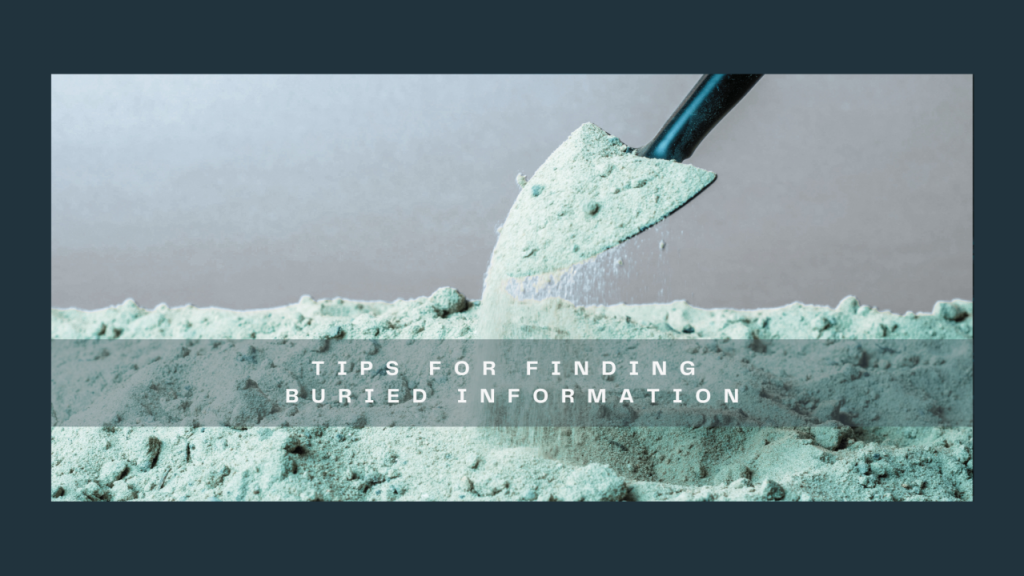
There are many opportunities to bury information in the patents. As patent searchers, it’s our job to investigate and locate this information. There are several ways information can be buried. Finding hidden information for your client is a win and shows diligence. There are some instances of patent searching where I have found information can be buried or hidden. With a few extra investigative steps, the information can be found. Of course, that is if it is indeed hidden and there in the first place.
Finding hidden information for your client is a win and shows diligence

Have you ever been asked to perform a search for a product in a particular name, entered the name into a patent searching database and zero hits returned? Technically the assignee name has been searched. Job done, yes? Not really. Here are a few extra steps that can be taken to uncover possible hidden information:
- Is the name you’ve been given a trademark name or an assignee name? A quick search in the US and GB trademark databases can locate the owner name. Once the owner has been located, enter this name into your patent searching database. UK trademarks can be searched here and US trademarks here.
- Look for other names the assignee may be known by and also names of companies acquired by the assignee. Try a quick Google search or look at the company about page.
- The patent/application may be in an inventor name. Try looking for any inventors associated with the company.
Is the name you’ve been given a trademark or an assignee name?

If a reference includes some features of interest, it could be beneficial to inspect the drawings/text of other family members to see if any extra relevant information is presented
For FTO searches, it’s usual to inspect each family member, this is especially important for US. For patentability/invalidity searches, simple families are relied upon. When keyword searches are performed, it’s clear to see in the text why a particular reference has been retrieved. If a reference includes some features of interest, it could be beneficial to inspect the drawings/text of other family members to see if any extra relevant information is presented. The representative publication of a family is a good place to start, but there may be additional or better information in another family member. This extra step is particularly useful for searching US as there are sometimes many family members.
Patent searching databases do make inspecting each family members less time consuming. Questel Orbit has the Keywords in Context (KWIC) feature and also means to easily view the full-text of each family member. Minesoft PatBase has means for easily viewing large mosaics drawings of each family member. Full-text of family members can be viewed in a separate pop-up window.
The representative publication of a family is a good place to start, but there may be additional or better information in another family member

When looking for obvious prior art, searching the title/abstract/claims is a must. However, if nothing has been located there, is it safe to assume that there isn’t any prior art? From experience, a little more digging is required. The full text is treasure trove, especially when it comes to patentability/invalidity searches. It’s always great when a relevant reference is found and it discloses all features in the abstract or claims, but more and more, information can be buried in embodiments. For a patentability/invalidity search, relevant information can be disclosed in the full-text. It’s important to look at all drawings of art close to the disclosure and also search full-text. It may feel like an unnecessary step but for completeness it’s a good step.
The full text is treasure trove, especially when it comes to patentability and invalidity searches

What if an attorney has not used these keywords to describe the invention? What can be done?
We can feel very confident in using keywords during a search, especially the prime keywords. The prime, most obvious, keywords should absolutely be used, however, what if an attorney has not used these keywords to describe the invention? What can be done?
- Search for the problem/solution. Describe the problem/solution using keywords. Questel Orbit has a useful field – object of invention (OBJ). Use the problem/solution keywords when searching this field.
- Zoom out and look at the field in general, especially if the area is niche.
- Search the most obvious assignees in the field of interest.
- If a disclosure contains features A + B + C, try searching A + B only. C may be disclosed in a way that you didn’t anticipate.

